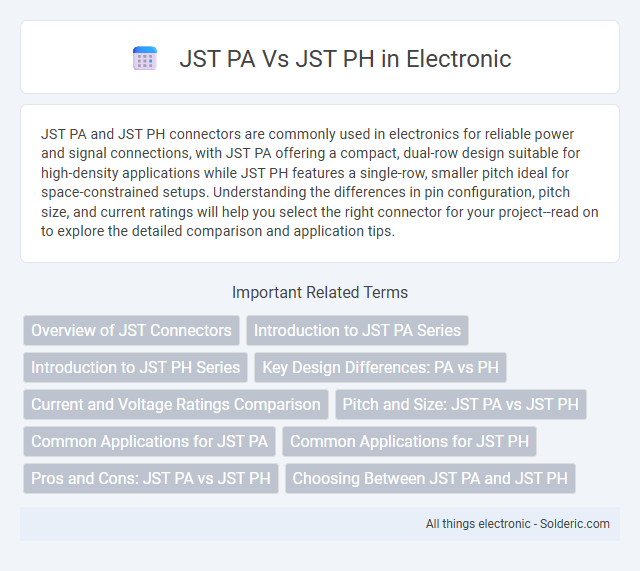JST PA and JST PH connectors are commonly used in electronics for reliable power and signal connections, with JST PA offering a compact, dual-row design suitable for high-density applications while JST PH features a single-row, smaller pitch ideal for space-constrained setups. Understanding the differences in pin configuration, pitch size, and current ratings will help you select the right connector for your project--read on to explore the detailed comparison and application tips.
Comparison Table
| Feature | JST PA Series | JST PH Series |
|---|---|---|
| Pitch | 2.0 mm | 2.0 mm |
| Connector Type | Locking header and housing | Standard header and housing |
| Locking Mechanism | Supports secure locking | No locking mechanism |
| Application | Ideal for secure connections in PCB assemblies | Commonly used in general electronic devices |
| Recommended Wire Size | 28-24 AWG | 28-24 AWG |
| Current Rating | 3A | 3A |
| Insertion Force | Higher due to locking | Lower, easy to insert |
| Typical Usage | Applications requiring vibrations resistance | Applications with minimal mechanical stress |
Overview of JST Connectors
JST PA and JST PH connectors are popular surface mount connectors used widely in electronic assemblies for reliable PCB connections. JST PA connectors generally feature a pitch of 2.0mm, supporting higher current capacities, making them suitable for power applications. JST PH connectors have a smaller pitch of 2.0mm, offering compact size ideal for signal transmission in tight spaces, ensuring Your devices maintain stable electrical contact.
Introduction to JST PA Series
The JST PA series connectors are compact, reliable, and designed for wire-to-board connections with a 2.0mm pitch, making them suitable for applications requiring small footprints and secure locking mechanisms. These connectors offer a robust connection with polarization features to prevent mis-mating and are widely used in consumer electronics and automotive devices. Your choice between JST PA and JST PH should consider PA's durability and secure latch suited for environments demanding vibration resistance.
Introduction to JST PH Series
The JST PH series is a popular line of connectors known for their compact 2.0mm pitch, making them ideal for small electronic devices and space-constrained applications. Unlike the JST PA series, which typically features a 2.5mm pitch, the PH series offers enhanced density and reliable connections in tighter spaces. These connectors are widely used in consumer electronics, battery pack connections, and LED lighting due to their balance of size and performance.
Key Design Differences: PA vs PH
JST PA connectors feature a single-row housing with a locking mechanism designed for secure connections in compact electronic devices, optimizing space and reliability. In contrast, JST PH connectors have a compact 2.0mm pitch with a vibration-resistant locking system suitable for applications requiring tight and stable connections. The PA series prioritizes easy mating and low-profile design, whereas the PH series emphasizes stability and durability in high-vibration environments.
Current and Voltage Ratings Comparison
JST PA connectors typically support current ratings up to 3A per contact with a voltage rating around 250V, making them suitable for moderate power electronic applications. In comparison, JST PH connectors generally handle lower currents, about 2A per contact, and have a voltage rating near 100V, ideal for low-power signal connections. Your choice between JST PA and PH should consider these current and voltage specifications to ensure compatibility with your project's electrical requirements.
Pitch and Size: JST PA vs JST PH
JST PA connectors feature a 1.0mm pitch, while JST PH connectors have a wider pitch of 2.0mm, influencing their compatibility with different PCB layouts and cable assemblies. The smaller pitch of JST PA makes it ideal for compact electronic devices requiring dense wire spacing, whereas the JST PH connector suits applications where increased spacing and robustness are necessary. You should choose JST PA for space-constrained projects or JST PH when a larger pitch and easier handling are priorities.
Common Applications for JST PA
JST PA connectors are commonly used in computer hardware, robotics, and various consumer electronics for reliable, compact power connections. Their design supports a secure mating mechanism, making them ideal for battery packs, LED strip connections, and small motors. You can expect JST PA connectors to provide consistent performance in applications demanding easy-to-use, space-saving power interfaces compared to JST PH connectors.
Common Applications for JST PH
JST PH connectors are widely used in applications requiring secure, compact connections such as computer motherboards, LCD displays, and consumer electronics due to their excellent locking mechanism and durability. These connectors provide reliable electrical signal and power transmission in automotive wiring harnesses and industrial equipment where vibration resistance is crucial. Compared to JST PA series, JST PH series is preferred for low-current, high-density applications with pitch sizes typically around 2.0 mm, optimizing space without compromising connection stability.
Pros and Cons: JST PA vs JST PH
JST PA connectors offer a compact design ideal for small electronic devices but have limited current capacity and may not withstand high vibration environments. JST PH connectors provide better durability and higher current ratings suitable for battery connections but are bulkier and less suitable for space-constrained applications. Choosing between JST PA and JST PH depends on balancing size constraints with electrical performance requirements.
Choosing Between JST PA and JST PH
Choosing between JST PA and JST PH connectors depends on your application's electrical and mechanical requirements. JST PA connectors offer a compact, lightweight design ideal for low-current, space-constrained projects, while JST PH connectors support slightly higher current capacities and provide secure locking mechanisms suitable for more demanding electronic devices. Understanding your device's current load and space limitations ensures you select the connector that optimizes performance and reliability for Your electronics.
JST PA vs JST PH Infographic

 solderic.com
solderic.com